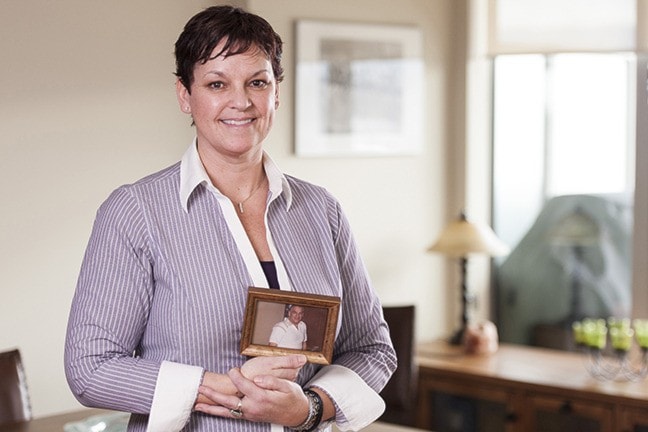Terry Farrell
Record staff
Mary Jaye Salmon will never forget the visit she received from the RCMP that morning.
“The police came to my door, first thing in the morning, to tell me,” she said of the receiving the news that her father had died, while on the job. “It was a car accident. Sunday night he was heading to do a presentation in Creston. Monday morning I got up to go to school, and I got a knock on my door.”
Mary Jaye was 18 at the time, and a first-year carpentry apprentice. Her father, Gerry, was a safety accident officer for what was then known as the Workmen’s Compensation Board of BC.
The death of her father was not the first brush with tragedy for Mary Jaye. Seven years earlier, her mother died of cancer.
“In a split second, I was left with no birth parents. It changed everything. And even though my dad was focused on safety in the workplace, he still died while doing his job.”
The irony of her father’s death – being a safety accident officer, and dying on the job – was not lost on Mary Jaye, although it was not a determining factor in her career path.
Following in her dad’s footsteps was a destined course for Mary Jaye, long before his death. It was during her mother’s illness that Mary Jaye began charting her course, which would eventually lead her to a career with WorkSafeBC as an occupational safety officer. When Mary-Jaye was 11 years old, her mom was diagnosed with cancer.
She would go to work with her dad, as a way to take her mind off of what was happening and to create some good times together. Mary-Jaye learned a lot about different jobs in different industries.
“I was always into things like carpentry,” she said. “Even in high school, I was taking woodworking when everyone else was taking home-ec. So the carpentry was engrained in me right off the get-go, and then the safety aspect, as I progressed in my carpentry career, it kind of just went hand in hand. I just got more and more interested. I knew how important it was to my dad – I just grew up with it. It was just one of those things.”
For Mary Jaye Salmon, her dad became a Day of Mourning statistic, even before the Day of Mourning existed. The federal government passed the Workers Mourning Day Act making April 28 an official Day of Mourning in 1991. She said at first she did not even make the connection, despite being so intimately involved with the Day of Mourning, from a professional perspective.
“It wasn’t even an event when dad passed. After it became an event it was like, wow, I guess my dad is one of those people. It took a couple of years before I even tied the two together. A lot of that was because of the circumstance. Even to this day... I always classified it as a motor vehicle accident, as opposed to him going to do his job. It wasn’t until the Day of Mourning came around when it dawned on me that, wow... ”
She said once the realization hit her, the Day of Mourning became much more intimate.
“It’s like a remembrance day for me, not only because of my personal connection, with what I’ve gone through, but also for all the other people who have suffered losses as well.”
Making workplace deaths a thing of the past is the ultimate goal of WorkSafeBC and while that may sound idealist to some, Mary Jaye Salmon said it is a practical target.
“Right now we are in this mode where occupational disease is where the majority of our deaths are occurring – due to the fact of the lack of knowledge and education back 20, 25 years ago. These are diseases that take a long time, normally, to show up.”
In 2015, 72 of the 122 deaths in B.C. were of the occupational disease variety. That has been the trend for the last few years.
Whereas the occupational disease numbers will take time to dissipate, the traumatic injury deaths are where WorkSafeBC is seeing a marked drop.
“That number is coming down all the time, and that’s what we really spend a lot of time focusing on that – education and consultation. Especially with young workers. And the general public is getting more educated too, and we are getting more calls from the general public about (work safety concerns). So it’s not just us watching.”
Mary Jaye said the most important message she continually passes along to employers regarding workplace safety is knowing what WorkSafeBC calls the four cornerstones of safety: Information; education; communication and supervision.
To learn more about the four cornerstones of safety, visit worksafebc.com
